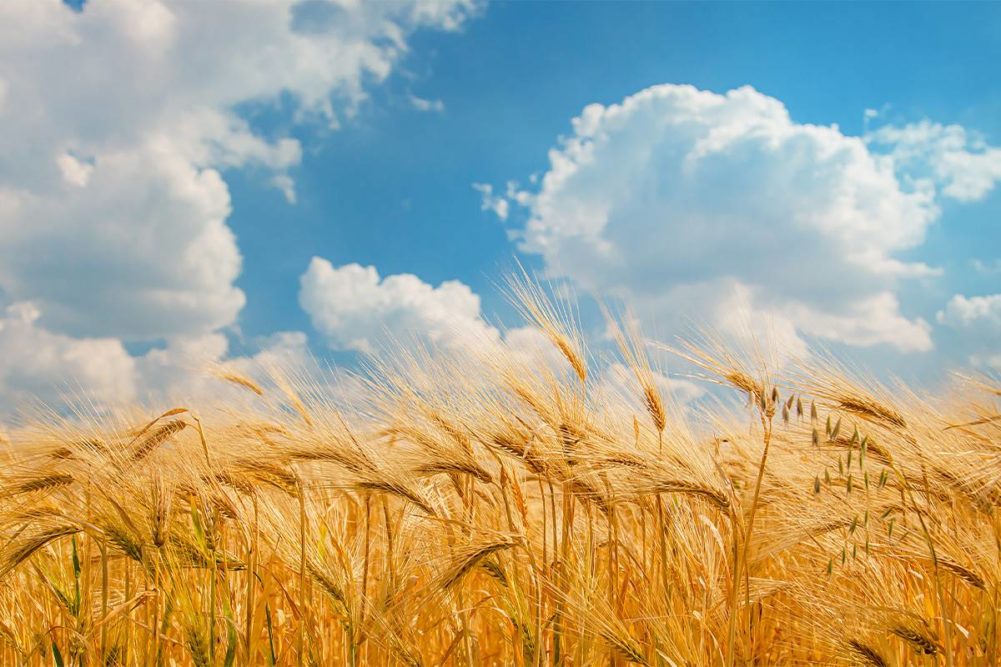MANDAN, ND. — Scattered precipitation and high humidity have further delayed progress in harvesting a 2022 US spring wheat crop that has been behind normal pace from the beginning. Much of the crop so far has been stored on farms, but that was expected to change next week when the harvest of later-planted fields begins in earnest.
The US Department of Agriculture in its Aug. 29 Crop Progress update indicated harvest completion a day earlier was at 50%, markedly behind 86% a year earlier and behind 71% as the 2017-21 average for the date.
Of the six states that harvested 100% of the 2021 acreage, only South Dakota at 92% and Montana at 75% harvested were ahead of their recent five-year averages for the date, 90% and 68%, respectively. Elsewhere, harvest completion was 34% in North Dakota (66% as the average), 44% in Minnesota (78%), 50% in Idaho (69%) and 61% in Washington (72%).
Sporadic rainfall in North Dakota, the nation’s top spring wheat production state, slowed harvest at the tail end of the week ended Aug. 27 and into the first days of the current week. But forecasts held warmth and dryness for the remainder of the week, and swift progress was expected.
The late nature of the crop has been felt by stakeholders along the wheat value chain.
“Out at the elevators, they’re saying it doesn’t feel like harvest yet because so much of the crop’s going into bins at home,” a veteran agribusiness analyst told Milling & Baking News. “They’re just not getting it in town yet. The early stuff went mostly into bins on the farm. Producers will determine a certain amount of on-farm space for corn, for soybeans, and for wheat, and when the wheat space is filled, they’re going to have to come to town with the balance of it, to put on storage or sell it.”
Timing when to sell naturally depends on the market, and growers aren’t keen to sell after the recent slide that saw Minneapolis spring wheat futures descend from mid-June highs above $12 to recent lows set in mid-August around $8.75.
“They’re not happy about selling it now when the market is down like this,” the analyst said. “They did sell some new crop stuff when it was over $9 the other day, and December’s tickling $9 again this week, but now they won’t think about selling when it’s all about staying busy in the field. Later planted wheat, more will come to elevators and the farmer will have 10 to 15 days to decide what to do with it. We haven’t heard of any deferred pricing programs for wheat, but on corn and soybeans, we’ve seen some deferred payments out to 2023 and out to 2024, which indicates they don’t need cash.”
Spring wheat conditions were mostly good with US spring wheat rated 68% good to excellent, up from 64% a week earlier and towering above 11% one year earlier as northern Plains growers were collecting the drought-diminished 2021 crop. Conditions were rated mostly good to excellent in the six states: 76% in North Dakota, 47% in South Dakota, 85% in Minnesota, 70% in Idaho and 94% in Washington. The exception was Montana at 41% good to excellent, 41% fair, and 18% poor to very poor. The USDA’s appraisal of the Aug. 23 Drought Monitor indicated 18% of spring wheat areas were in drought. The accompanying map indicated the majority of that area was in the west-central and north-central areas of Montana, as well as smaller areas of western South Dakota and southern Minnesota.
Production numbers have varied widely in North Dakota, but quality has been good overall with no major issues or concerns reported to the North Dakota Wheat Commission.
“Yield reports so far have varied quite a bit with some producers reporting yields below expectations and many finding yields higher than expected,” ND Wheat said in its Aug. 30 weekly wheat update. “Yield varies depending on area and planting date. Test weights have been strong with most in the 60 to 62 lbs per bu range. Protein levels have been slightly lower in some areas, but the overall reported range is 12.5% to 16% protein, which indicates a fairly average protein year so far.”
One early concern for the crop appears to have died down.
“Nobody’s talking about grasshoppers right now as they were during the spring wheat tour,” the analyst said. “Ergot is the only thing we’re hearing about, and it’s not prevalent enough to get people alarmed or excited. There were concerns with the most recent rain, because the crop was showing good color and good dark vitreous kernels, so the hope is the rain wasn’t lengthy enough to strip away some of the color.”
As for durum wheat, harvest was picking up pace in North Dakota, ND Wheat said. The state’s crop was 31% harvested by Aug. 28 compared with 72% a year earlier and 50% as the 2017-21 average for the date. Although maturity at 63% remained well behind 98% a year earlier and 89% as the five-year average, North Dakota growers hoped to make rapid progress this week as conditions warmed and humidity was expected to die down a bit. ND durum wheat coloring was 93%, behind 100% last year and 99% as the average.
Montana durum harvest has progressed at a slightly quicker clip jumping from 38% a week earlier to 61% harvested by Aug. 28, close to 66% completion a year earlier and outpacing the five-year average pace of 53%.





